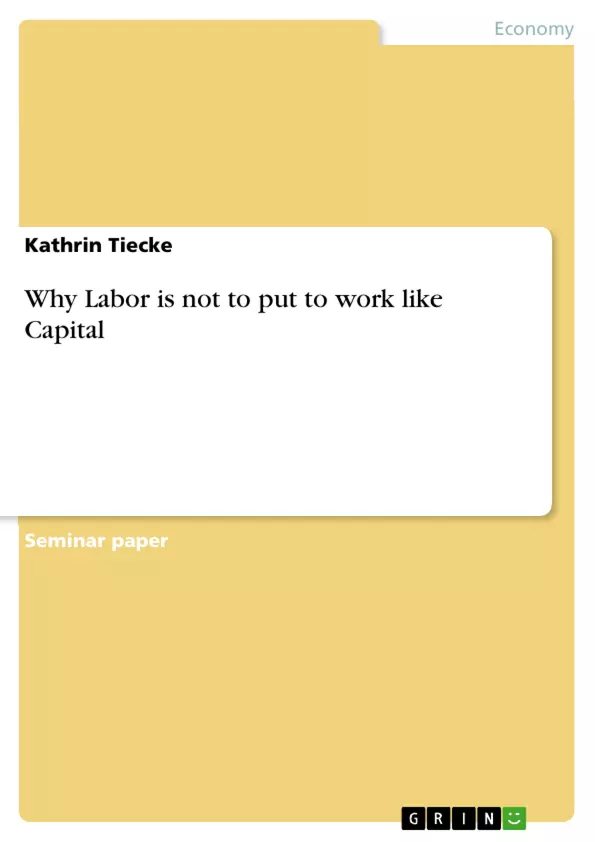At the end I want to refer again to Fehr and Gächter (2002). They have shown that framing has an effect on individual’s behavior. A bonus pay is experienced as more friendly than being threatend to pay a fine. As we face today a financial crisis, a discussion about incentive contracts has been started immediatly. It is claimed, that incentive contracts of bankers or so called “rist-takers” have been the driving force towards the crisis. The BaFin advices the financial branch to lower the share of incentive contracts among their employees. In order to cut the bonus payment a higher fixed-wage ought to be payed. Obviously bonus payments are ment to lead to higher levels of effort, but it might be a question of definition what effort means in the short and in the long run. Since fixed-wage labor contracts are characterized by weak performance incentives, one could concider incentive contracts as the best alternative, including explicit performance incentives. But this is rather a costly action. Taking the experimental findings of Fehr et al. (2002) into account one could claim that a fixed-wage contract does better on voluntary cooperation than incentive contracts, since the highest voluntary cooperation has been observed in the trust treatment. Recently several financial institutions lowered the bonus payments and therefore induced higher fixed wage-payments. I think, if a worker already receives a “high” wage in the sense of above average wage (depending on its definition), the bonus incentive might fails to lead in a higher intertemporal effort. It makes the worker act as a risk-neutral or even riskless worker. This may not lead to a profitable outcome in the long run and it might be more
profitable to pay a higher fixed wage. Additionally one can let the employee pay a fine, hidden beyond an extra wage account e.g. “held for failures”, which would result in a lower effort level (at least as the theory predicts), but in tendencies one might observe more reasonable extend of taking risks.
In the future, experimental economics may examine the impact of incentives on risk behavior. Do individuals become risk-neutral when they face different incentive contracts, although they were risk-averse before? This may be not quite easy to test in the laboratory, but serveys or field studies could provide answeres.
Experiments may help to search for a “risk-aversion boarder”, and also help to understand why there is even more selfish behavior in excess stake.
Inhaltsverzeichnis (Table of Contents)
- Introduction
- The Partial Gift Exchange Model
- The Neoclassical Model of the Labor Market
- Social Preferences
- Sources of Social Preferences
- A Gift-Exchange Experiment
- “Does Fairness prevent Market Clearing? An Experimental Investigation\" by Fehr et al. (1993)
- Experimental Design
- Experimental Predictions and Results
- An amended Version of the latter Gift-Exchange Experiment
- “Do incentive contracts undermine voluntary cooperation?\" by Fehr et al. (2002)
- Experimental Design
- Experimental Predictions and Results
- Conclusion
- Literature
- Positive Analysis and Personal View
Zielsetzung und Themenschwerpunkte (Objectives and Key Themes)
This seminar paper aims to explore the concept of the gift exchange model and its implications for the labor market. It analyzes why the classical model of labor markets fails to explain certain observed economic phenomena and proposes an alternative approach based on social preferences.
- The Partial Gift Exchange Model and its theoretical foundations.
- The role of social preferences, particularly fairness, in shaping economic behavior.
- Experimental evidence supporting the gift exchange hypothesis in labor markets.
- The impact of incentive contracts on voluntary cooperation.
- Implications for understanding the labor market and developing economic policies.
Zusammenfassung der Kapitel (Chapter Summaries)
The paper begins by introducing the partial gift exchange model and the neoclassical model of the labor market. It highlights the shortcomings of the neoclassical model in explaining labor market behavior, particularly the existence of involuntary unemployment. The paper then delves into the concept of social preferences, focusing on fairness as a crucial factor in economic decisions.
The subsequent sections present two experimental studies, conducted by Fehr et al. (1993) and Fehr and Gächter (2002), which investigate the influence of fairness on labor market outcomes. The first study examines the impact of fairness on market clearing in a controlled environment. The second experiment investigates whether incentive contracts undermine voluntary cooperation among individuals.
Schlüsselwörter (Keywords)
The primary keywords and focal topics of this paper include: gift exchange, social preferences, fairness, labor market, experimental economics, involuntary unemployment, incentive contracts, voluntary cooperation, neoclassical model, and principal-agent relationships. This paper explores these concepts within the context of the labor market and provides empirical evidence for their influence on economic behavior.
- Citation du texte
- Kathrin Tiecke (Auteur), 2010, Why Labor is not to put to work like Capital, Munich, GRIN Verlag, https://www.grin.com/document/162487



